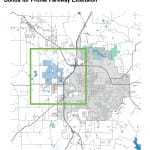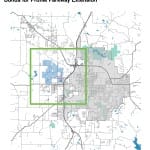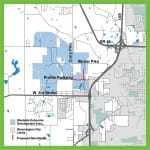Bloomington city council gets assurance: county redevelopment commission’s planned new roads will have sidewalks



Monroe County attorney Jeff Cockerill presented a proposal to Bloomington’s city council Wednesday night that will use revenue from the West Side TIF (tax increment financing) District to pay for two new roads in the area southeast of the intersection of Vernal Pike and Curry Pike.
One of the two-lane roads will extend Profile Parkway to Gates Drive. The other will extend Sunrise Greeting Court from Vernal Pike down to Gates Drive. The roads are meant to promote development on the interior of the area bounded by Vernal Pike, Curry Pike and Third Street. Cockerill said the new roads are also supposed to alleviate traffic congestion—they’ll give motorists a reason not to use Curry Pike and 3rd Street as much.
Cockerill first explained why he was there at all. After the Westside TIF district was established, in the early 1990s, the city annexed some land in the district. It includes the parcel where Lowe’s sits. So a TIF district that was established by the county includes land that’s now inside the city.
That’s why Cockerill was in city council chambers—to answer any questions they had before councilmembers vote next week on the issuance of $8 million worth of bonds. Wednesday’s city council session was a committee-of-the whole meeting, so their 8–0 straw poll was a prediction of where they’ll stand when they take a vote next week. (Andy Ruff was absent.)
The roads project is being overseen by the county’s redevelopment commission. When its president, Efrat Feferman appeared in front of the city council on Wednesday, she added to the reasons why the commission was supporting the project. Curry Pike is a dangerous road, she said, and the new, internal roads will give people alternatives to Curry.
Numbers from city-data.com show seven fatal crashes on Curry Pike since 1982. The city’s B Clear Portal includes a dataset with crash data from 2003 to 2015 showing a couple dozen crashes on Curry Pike that caused an incapacitating injury or death.
At Wednesday’s session, councilmember Isabel Piedmont-Smith wanted to know if the planned new roads would be “complete streets”—that is, include bicycling and pedestrian infrastructure. Cockerill’s initial response was that he believed they did, because they meet the INDOT standards for roads. Councilmember Steve Volan later cautioned that meeting the state’s standards did not necessarily mean that things like bicycle lanes or sidewalks would be included.
Cockerill said that for the plans he’d seen for the bridge that will go over the railroad tracks, there’s a way for bicyclists and pedestrians to go across it. That satisfied Volan that the roads would include infrastructure for bicyclists and pedestrians.
When Greg Alexander took the podium to give public commentary, he confirmed Cockerill’s information. Alexander said the county’s urbanizing area plan requires such roads to have sidewalks. Alexander said the design he’d seen for the roads showed a 10-foot sidewalk on one side and a 5-foot sidewalk on the other and a “substandard” bicycle lane.
Even though he had concerns about the design of the planned new roads, Alexander said, it was “miles ahead” of the city’s approach to sidewalks. Alexander told the city council, Gates Drive has sidewalks on almost all of it. But at the very end of Gates, where it meets 3rd Street, 200 feet of sidewalk is missing on both sides of the street, he said.
Alexander told the council it is important for the city to have a sidewalk network, so that when a county project is built, there’s a network to which the county can connect.
It’s not the city staff’s fault, Alexander said, that these sidewalk gaps exist. The city had generally not budgeted enough money for sidewalks. The size of the council’s sidewalk committee’s budget, Alexander said, is a “joke.”
The city’s budget for 2020, which the council will vote on in early October, proposes to increase the alternative transportation fund for sidewalk construction by $6,000 to $324,000.
On Wednesday, councilmembers didn’t dwell on the details of TIF capture that led to the somewhat odd circumstance of the county seeking the city’s approval for TIF bonds.
City taxes paid on the parcels in the now-annexed area aren’t captured by the county’s TIF, but the county taxes are subject to capture. It’s not all the taxes on the property that are captured. It’s the value of the increment, between the base value when the district was established and the value of improvements, that generates revenue to the TIF district.
In 2017, Monroe County’s West Side TIF district had a $60,683,346 base value, and an increment value of $119,854,231, which generated $1,914,271 in revenue. There are 129 properties in the district. The property with the largest increment, at $24,877,565, is one owned by Cook, Inc.
Earlier on WednesdayOn Tuesday, the $8 million bond proposal had won approval from the board of county commissionerscounty council. It will appear on the city council’s Sept. 18 agenda for a vote.




Comments ()